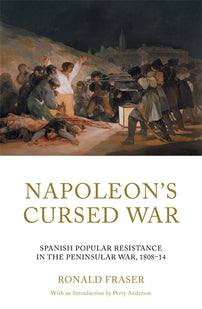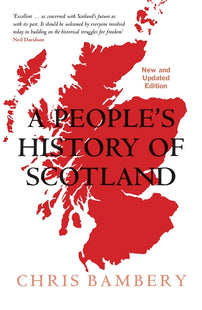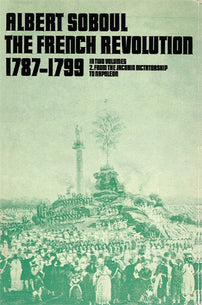The Popular Resistance Napoleon Could not Defeat
Chris Bambery, author of A People’s History of Scotland, reviews Ronald Fraser’s Napoleon’s Cursed War, out now in paperback.

**This article was originally published in Counterfire.
One of Francisco Goya’s greatest paintings, El dos de mayo (Second of May) shows something unique in all the wars fought by the French dictator and emperor, Napoleon Bonaparte: a mass, urban insurrection against his occupying forces. On 2 May 1808, Madrid, recently occupied by the French, boiled over into a riot after weeks of fear and tension. This became a rebellion when the French commander, Napoleon’s brother-in-law, Joachim Murat, sent in infantry and cavalry who promptly opened fire on the crowds.
It was the opening act in what would become a popular war of resistance across Spain to the French occupation, as Ronald Fraser chronicles superbly in this excellent history. May 1808 saw other insurrections follow, but these were in towns and cities then free of French troops, and were aimed at the Spanish prime minister’s, Manuel Godoy, placemen in the authorities there and those seen as sympathetic to the French.
Goya would also paint the El tres de mayo (Third of May) showing a French execution squad shooting captured rebels in the Casa de Campo across the River Manzanares from Madrid. The two paintings hang together in Madrid’s Prado Museum. The war that would follow the Madrid uprising transformed Goya from a court painter, albeit of exceptional skill, into a great modern war artist. His 82 prints, Los desastres de la guerra (The Horrors of War), bring home the dreadful savagery on both sides of that cursed war.
Why did Napoleon get drawn into such a long and costly war? It lasted until his first abdication in 1814. Back in 1793, the Kingdom of Spain, alongside Austria and Prussia, went to war with revolutionary France. The Spanish army’s leadership was corrupt and inefficient, the treasury of the government of King Carlos IV was bare.
Yet, when the French invaded their country in 1808, ordinary Spaniards rose up in arms under the slogan ‘Religion, King and Country’. Spain might be miserably poor, but the population was faithful to the Church, hated the atheist French, and was prepared to defend their community (though loathe to fight beyond it). Guerrilla war began in Spain, and Spanish gave us a word which would become globally familiar in the twentieth century.
Earlier, in 1795, France’s youngest general had believed a land war in Spain was unwinnable because of the popular resistance it would spawn. But Napoleon must have forgotten his views from back then, when in 1808 he ordered the invasion and occupation of both Spain and Portugal. His armies prevailed over those of both kingdoms, but popular resistance could not be crushed and a very bloody conflict continued with the French unable to suppress that resistance.
[book-strip index="1"]
Looking back in exile on St Helena he stated, ‘that cursed war with Spain was the main cause of France’s misfortunes.’ He also referred to it as the ‘Spanish ulcer’. Ronald Fraser’s Napoleon’s Cursed War details Spanish popular resistance to Napoleon’s occupation forces between the initial invasion in 1808 to the retreat back over the border in 1814. First published by Verso to critical acclaim in 2008, they have now brought out a new edition with an introduction by Perry Anderson detailing Fraser’s fascinating life.
Napoleon decided on occupying the Iberian Peninsula for a number of reasons. Firstly, in 1807, he had demanded that all states in continental Europe cease trading with Britain in the hope this would bring its economy to its knees. Portugal formally agreed, but kept trading with its old ally so Napoleon determined to stop this. Secondly, he hoped to release the Spanish navy, bottled up in Cádiz, along with a French fleet, after Nelson’s victory in 1803 at Trafalgar. Thirdly, he was contemptuous of the Borbón monarchy (a branch of the French House of Bourbon) whom he saw as incompetent, corrupt and decadent, holding back Spain’s development. Their replacement could unleash the country’s potential and allow it to be a valuable part of his empire.
To that end, he saw how he could exploit Spanish political divisions. On the one hand, there was the ruling King Carlos IV, who was weak and stupid, dominated by his Queen, María Luisa, with the country in the effective control of her favourite, the hated chief minister Manuel Godoy. On the other, there was the heir to the throne, Ferdinand, backed by large group of nobles who resented Godoy.
Napoleon’s first move was to ensure Godoy and Carlos IV agreed a French army could cross the country to capture Portugal. Ferdinand did not disagree about that because he believed Napoleon would back him in taking the crown. Instead, French troops started taking fortresses and garrisoning them. It became clear they were there to stay, not just passing through, and more and more of them arrived.
Napoleon’s chance to deal with the Borbóns came in March 1808 at the royal palace of Aranjuez, to which the royal family had removed themselves, when an uprising by Ferdinand’s supporters forced Carlos IV to abdicate, and removed Godoy from office. Ferdinand acceded as King Ferdinand VII. He then decided to move north to Madrid, but when Murat arrived first and took over the city, Spanish forces simply retreated.
Napoleon then played off the Borbóns, pretending he favoured Carlos IV to one, and Ferdinand VII to the other. Eventually both were in Madrid and Murat ensured they accepted the Emperor’s invitation to come to Bayonne, across the frontier in France, to decide the matter. Once there, both were forced to renounce the throne and both (along with Godoy and Carlos’s wife) put under house arrest in France.
When Napoleon placed his brother Joseph on the throne of Spain on 15 June 1808, it meant the uprising gathered even greater momentum. A month later, on 16 July, the Spanish Army of Andalusia attacked French troops near Bailén, and gave the French Empire its first defeat in the long war. Both sides would learn the bitter taste of defeat.
[book-strip index="2"]
The risings which followed the Dos de Mayo were encouraged by elite supporters of Ferdinand, but were driven in many cases by the lower classes. In the Madrid insurrection, the largest contingent came from those in low-paid ‘petty-service’ jobs – servants, inn porters and such like – the next biggest were artisans followed by labourers, which included large numbers of women.
The lower classes dominated the actual fighting, but not the Juntas, the independent governing councils which were formed in opposition to the French takeover. These were generally led by the three established estates, the nobility, clergy and bourgeoisie (not in today’s sense, but the relatively small mercantile class). In some areas, the lower orders were represented, usually through the guilds, in others not. Functionaries identified with Godoy were killed, meaning the power of the state evaporated and the Juntas took effective control. In Oviedo, with its sizable garrison, and the naval base of Cartagena, army and naval officers took matters into their own hands and controlled the Junta.
Napoleon and Joseph Bonaparte did introduce a number of progressive reforms, but they won little favour from the bulk of Spaniards who hated foreign control and rallied to their traditional rulers, the nobles and clergy. The resistance united all classes and was in many ways a democratic movement, but one fighting, in the main, for a deeply reactionary cause. Fraser eloquently describes the May-June 1808 insurrection as ‘the common people’s Baroque victory over the Enlightenment’ (p.106).
There was one area of Spain where the industrial revolution was underway, Catalonia, based, as in Britain, on small family-owned textile firms. In Manresa, there were 2000 journeymen employed in the textile mills, but by 1808 they were mainly unemployed with the markets for their textiles in Latin America cut off. This also had an impact on the nation’s peasant farmers, many of whom had grown grapes to make the firewater sent there.
In Catalonia, an armed militia existed too, the Sometent, raised to defend it from French invasion in the earlier war Spain had waged against revolutionary France. The uprising in Catalonia spread across the country, which meant the French did not have enough troops to control all of it. They could hold down Barcelona, but when a column was sent from the city to crush the uprising in Lleida, where it began in Catalonia, the Sometent were aided by Swiss and Walloon soldiers serving in the Spanish army.
But the Juntas in Catalonia followed the pattern elsewhere in the Spanish kingdom, dominated by the upper classes, and the risings were in support of Ferdinand, even though the Borbón dynasty had in 1714 conquered the country, abolishing its autonomy and persecuting the language. Fraser explains this thus: ‘There can be no doubt that in 1808 and throughout the war the principality’s inhabitants felt themselves Catalan above all … The Catalans had not yet turned their sense of a distinct identity into a political project. That would take another three quarters of a century.’
Hatred of the French invader and their invasion, loyalty to their clergy, and the bourgeoisie’s desire for markets in Spain and the colonies meant they fought under the same banner of king, religion and fatherland as elsewhere.
[book-strip index="3"]
Napoleon’s retreat from Moscow meant that by March 1813, French armies in eastern Europe were falling back to the Elbe River. Prussia re-entered the war against France on 16 March. Short of troops, Napoleon could spare none for the Peninsula as he prepared to counter-attack in the east. Wellington’s army in Portugal, the only British one on the Continent, was strongly reinforced. Wellington would begin a cautious advance into Spain, supported by Spanish armies and aided by the guerrillas holding down thousands of French troops.
Ferdinand would return, but from the moment he crossed the border from France, hopes he would agree to become a constitutional monarch were dashed. After the defeat of Napoleon, backed by the victorious Allied powers and by his restored Bourbon cousin in Paris, he was determined to restore absolutism. He and his successors would become by-words for their venality, corruption and repression.
The war had an impact on Spain in ways which would echo down over the coming decades. Firstly, largely cut off from the mother country, the Latin American colonies began to assert their independence. With the return of Ferdinand and absolutism, they rose in revolt, encouraged by Britain, who saw commercial opportunities. By 1822, they were independent, although not free of imperial interventions. Loss of empire, later followed by Cuba and the Philippines breaking away after the 1898 Spanish-American war, led to a palpable sense of decline.
The loss of empire was accompanied by a growing polarisation at home between those who supported absolutism and those who favoured a constitution along the lines of the liberal 1812 Cádiz constitution created during the war of resistance against the French. This polarisation would also see a split in the absolutist camp with supporters of one claimant to the throne following Ferdinand’s death, his brother, fighting three civil wars to oust the king’s chosen successor, his daughter.
The divisions between traditionalists and liberals were at an elite level within an aristocratic oligarchy which ruled Spain into the last century. Both sides hated the Catalan industrialists and kept them away from power. In this situation, the army carved out a niche for itself by becoming the force which would decide who took over the reins of government through a series of short, sharp military coups. Those chickens would come home to roost in 1936 with a military uprising sparking a civil war whore brutality mirrored that of 1808-1814, and more!
Returning to Napoleon on St Helena, he wrote in his memoirs of Spain: ‘That unfortunate war destroyed me; it divided my forces, multiplied my obligations, undermined my morale. All the circumstances of my disasters are bound up in that fatal knot.’ In truth, his invasion of Russia and the subsequent retreat from Moscow was the decisive turning point, but there was no cure for his ‘Spanish ulcer’ and its major drain on France’s armies and resources.
Ronald Fraser has produced a fine history of the popular resistance Napoleon could not defeat.


